Comprehensive Analysis: Australian Anti-Piracy Law 2015
VerifiedAdded on 2023/06/08
|12
|3091
|428
Report
AI Summary
This report provides a comprehensive analysis of the Australian Anti-Piracy Law 2015. It begins with an executive summary and table of contents, followed by an introduction to the law and its controversial nature. The report details the law's uses, primarily to combat piracy within the entertainment and technology industries, and explores its aims to block websites distributing copyrighted content illegally. It also addresses potential misuses of the law, such as false allegations of content ownership, and discusses whether the law will be effective, considering factors like content providers' reliance on piracy websites and the evolution of technology. The report concludes by suggesting alternative approaches, such as government-supported platforms for copyrighted content distribution and public education on piracy's effects. References are provided to support the analysis.
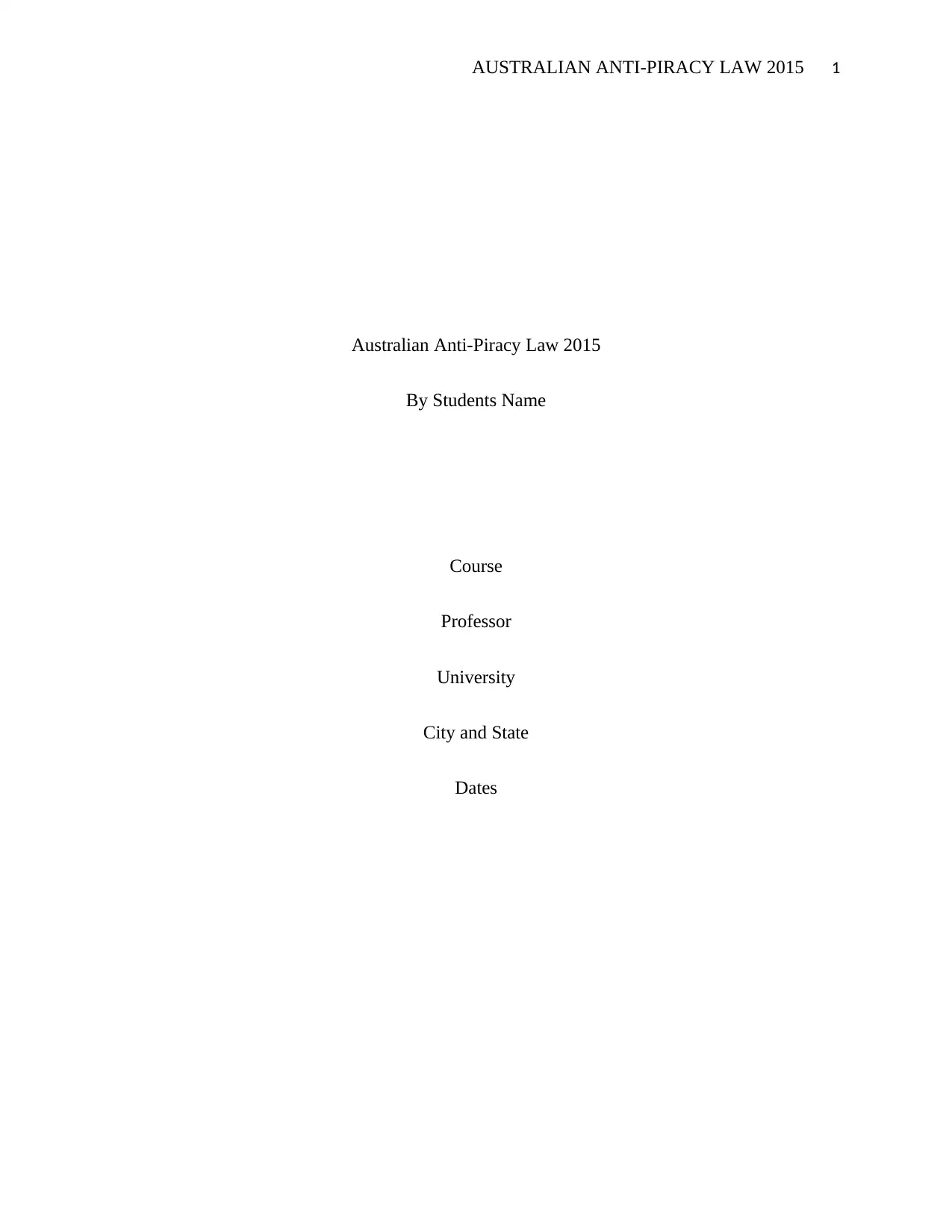
AUSTRALIAN ANTI-PIRACY LAW 2015 1
Australian Anti-Piracy Law 2015
By Students Name
Course
Professor
University
City and State
Dates
Australian Anti-Piracy Law 2015
By Students Name
Course
Professor
University
City and State
Dates
Paraphrase This Document
Need a fresh take? Get an instant paraphrase of this document with our AI Paraphraser
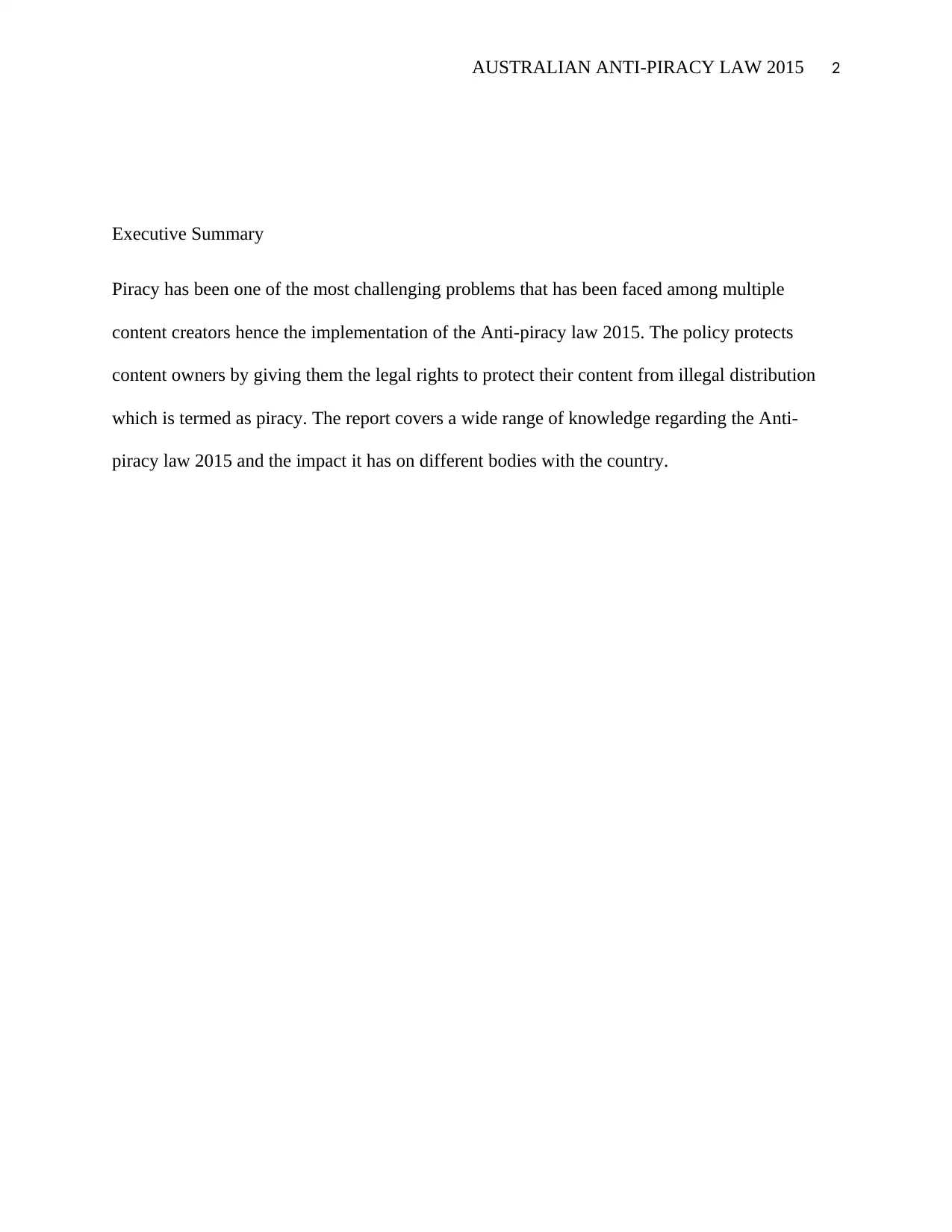
AUSTRALIAN ANTI-PIRACY LAW 2015 2
Executive Summary
Piracy has been one of the most challenging problems that has been faced among multiple
content creators hence the implementation of the Anti-piracy law 2015. The policy protects
content owners by giving them the legal rights to protect their content from illegal distribution
which is termed as piracy. The report covers a wide range of knowledge regarding the Anti-
piracy law 2015 and the impact it has on different bodies with the country.
Executive Summary
Piracy has been one of the most challenging problems that has been faced among multiple
content creators hence the implementation of the Anti-piracy law 2015. The policy protects
content owners by giving them the legal rights to protect their content from illegal distribution
which is termed as piracy. The report covers a wide range of knowledge regarding the Anti-
piracy law 2015 and the impact it has on different bodies with the country.
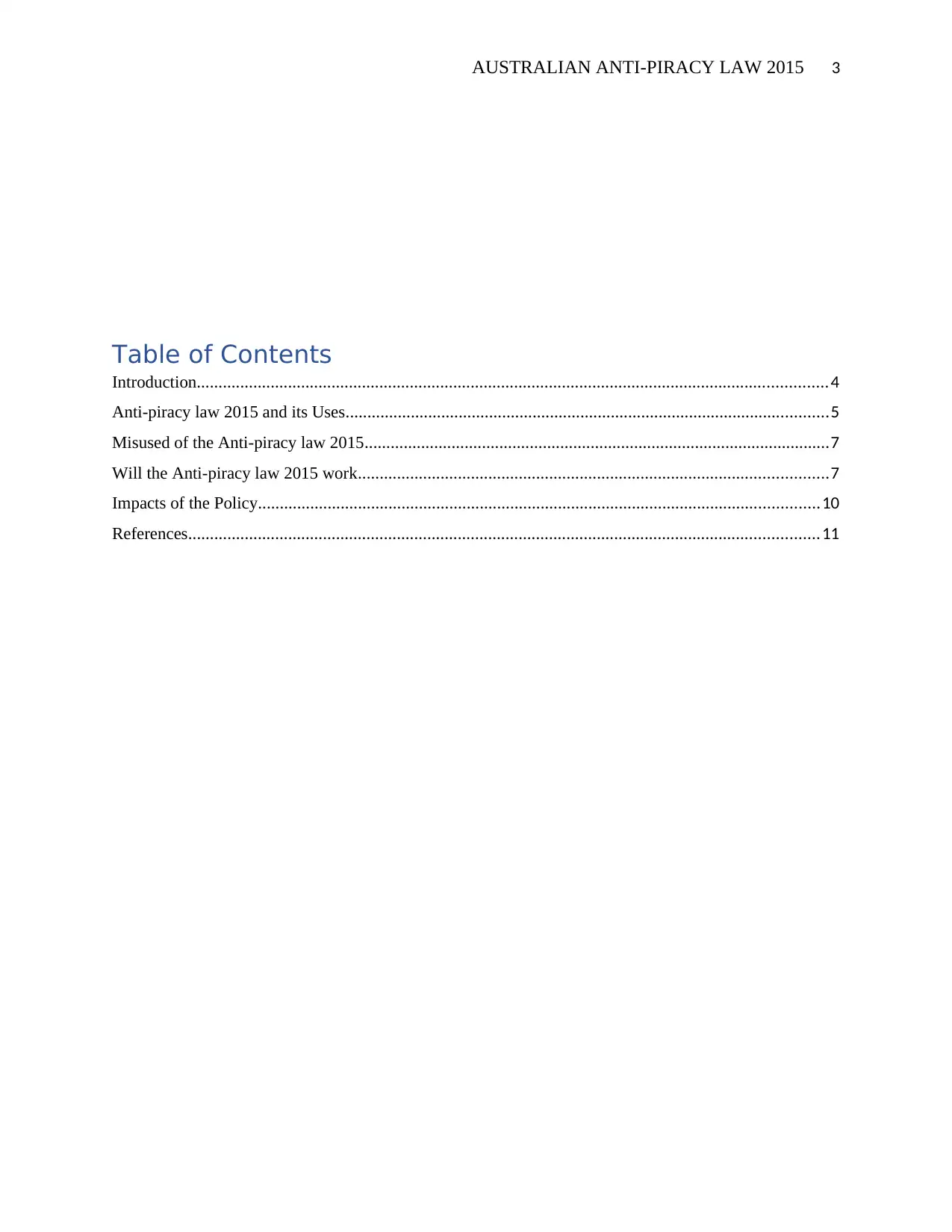
AUSTRALIAN ANTI-PIRACY LAW 2015 3
Table of Contents
Introduction.................................................................................................................................................4
Anti-piracy law 2015 and its Uses...............................................................................................................5
Misused of the Anti-piracy law 2015...........................................................................................................7
Will the Anti-piracy law 2015 work............................................................................................................7
Impacts of the Policy.................................................................................................................................10
References.................................................................................................................................................11
Table of Contents
Introduction.................................................................................................................................................4
Anti-piracy law 2015 and its Uses...............................................................................................................5
Misused of the Anti-piracy law 2015...........................................................................................................7
Will the Anti-piracy law 2015 work............................................................................................................7
Impacts of the Policy.................................................................................................................................10
References.................................................................................................................................................11
You're viewing a preview
Unlock full access by subscribing today!
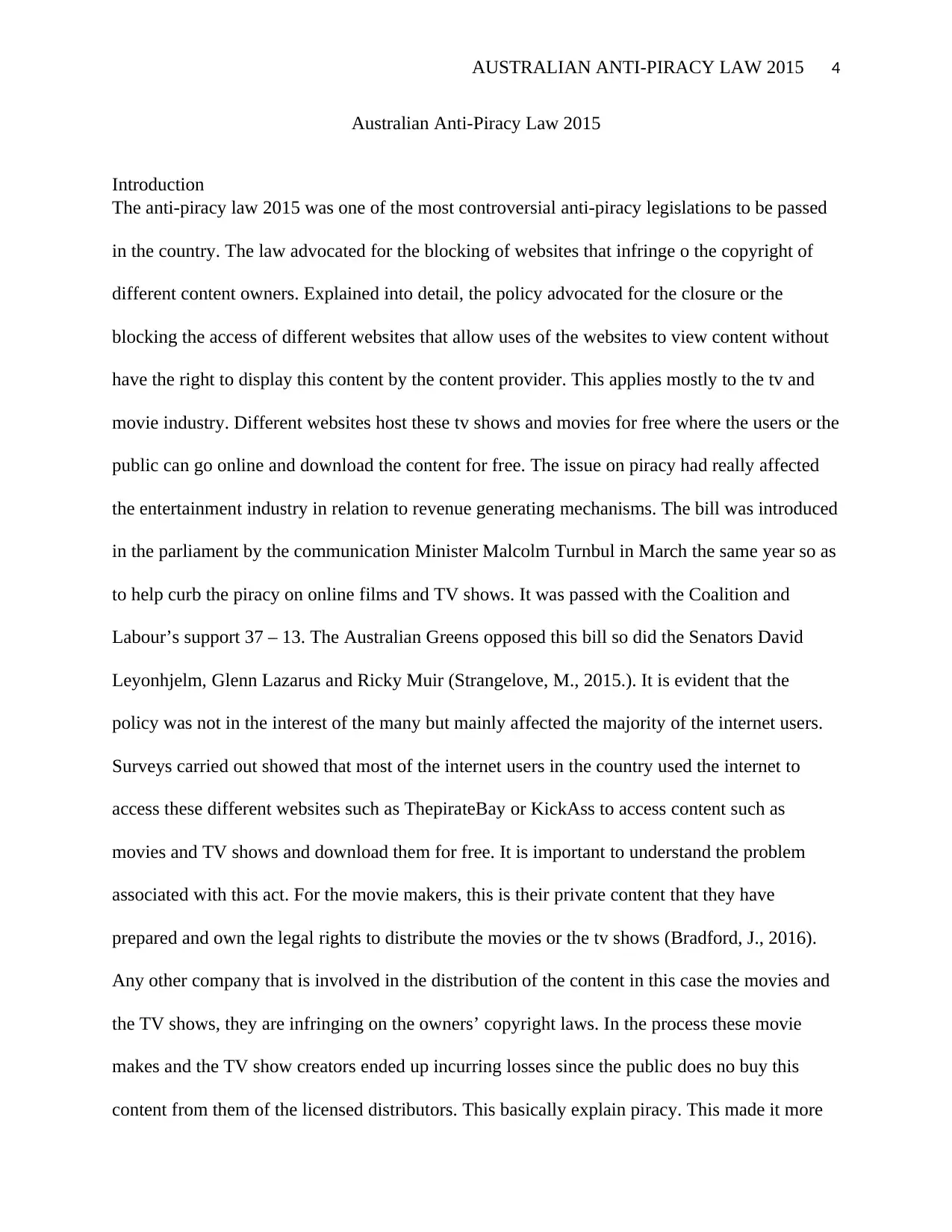
AUSTRALIAN ANTI-PIRACY LAW 2015 4
Australian Anti-Piracy Law 2015
Introduction
The anti-piracy law 2015 was one of the most controversial anti-piracy legislations to be passed
in the country. The law advocated for the blocking of websites that infringe o the copyright of
different content owners. Explained into detail, the policy advocated for the closure or the
blocking the access of different websites that allow uses of the websites to view content without
have the right to display this content by the content provider. This applies mostly to the tv and
movie industry. Different websites host these tv shows and movies for free where the users or the
public can go online and download the content for free. The issue on piracy had really affected
the entertainment industry in relation to revenue generating mechanisms. The bill was introduced
in the parliament by the communication Minister Malcolm Turnbul in March the same year so as
to help curb the piracy on online films and TV shows. It was passed with the Coalition and
Labour’s support 37 – 13. The Australian Greens opposed this bill so did the Senators David
Leyonhjelm, Glenn Lazarus and Ricky Muir (Strangelove, M., 2015.). It is evident that the
policy was not in the interest of the many but mainly affected the majority of the internet users.
Surveys carried out showed that most of the internet users in the country used the internet to
access these different websites such as ThepirateBay or KickAss to access content such as
movies and TV shows and download them for free. It is important to understand the problem
associated with this act. For the movie makers, this is their private content that they have
prepared and own the legal rights to distribute the movies or the tv shows (Bradford, J., 2016).
Any other company that is involved in the distribution of the content in this case the movies and
the TV shows, they are infringing on the owners’ copyright laws. In the process these movie
makes and the TV show creators ended up incurring losses since the public does no buy this
content from them of the licensed distributors. This basically explain piracy. This made it more
Australian Anti-Piracy Law 2015
Introduction
The anti-piracy law 2015 was one of the most controversial anti-piracy legislations to be passed
in the country. The law advocated for the blocking of websites that infringe o the copyright of
different content owners. Explained into detail, the policy advocated for the closure or the
blocking the access of different websites that allow uses of the websites to view content without
have the right to display this content by the content provider. This applies mostly to the tv and
movie industry. Different websites host these tv shows and movies for free where the users or the
public can go online and download the content for free. The issue on piracy had really affected
the entertainment industry in relation to revenue generating mechanisms. The bill was introduced
in the parliament by the communication Minister Malcolm Turnbul in March the same year so as
to help curb the piracy on online films and TV shows. It was passed with the Coalition and
Labour’s support 37 – 13. The Australian Greens opposed this bill so did the Senators David
Leyonhjelm, Glenn Lazarus and Ricky Muir (Strangelove, M., 2015.). It is evident that the
policy was not in the interest of the many but mainly affected the majority of the internet users.
Surveys carried out showed that most of the internet users in the country used the internet to
access these different websites such as ThepirateBay or KickAss to access content such as
movies and TV shows and download them for free. It is important to understand the problem
associated with this act. For the movie makers, this is their private content that they have
prepared and own the legal rights to distribute the movies or the tv shows (Bradford, J., 2016).
Any other company that is involved in the distribution of the content in this case the movies and
the TV shows, they are infringing on the owners’ copyright laws. In the process these movie
makes and the TV show creators ended up incurring losses since the public does no buy this
content from them of the licensed distributors. This basically explain piracy. This made it more
Paraphrase This Document
Need a fresh take? Get an instant paraphrase of this document with our AI Paraphraser
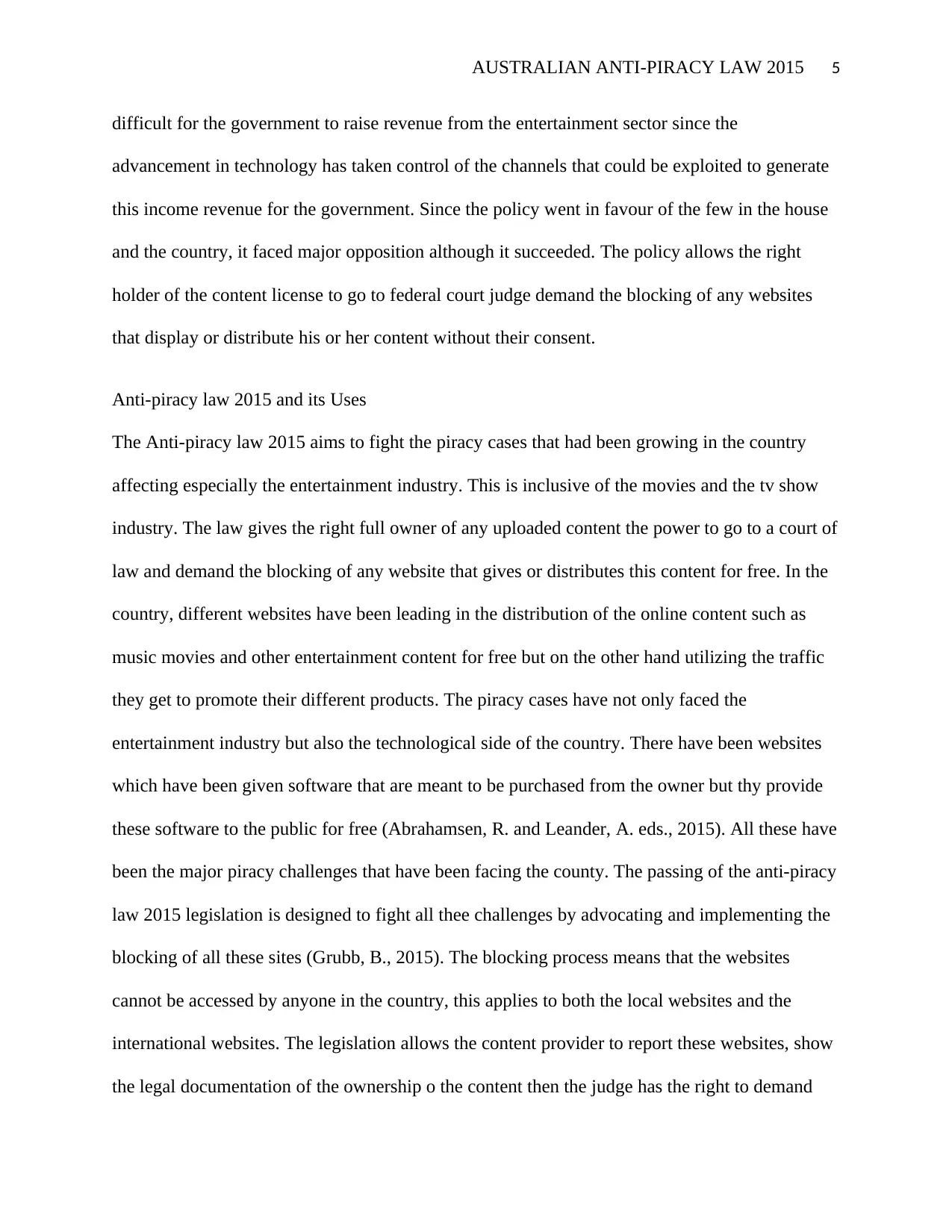
AUSTRALIAN ANTI-PIRACY LAW 2015 5
difficult for the government to raise revenue from the entertainment sector since the
advancement in technology has taken control of the channels that could be exploited to generate
this income revenue for the government. Since the policy went in favour of the few in the house
and the country, it faced major opposition although it succeeded. The policy allows the right
holder of the content license to go to federal court judge demand the blocking of any websites
that display or distribute his or her content without their consent.
Anti-piracy law 2015 and its Uses
The Anti-piracy law 2015 aims to fight the piracy cases that had been growing in the country
affecting especially the entertainment industry. This is inclusive of the movies and the tv show
industry. The law gives the right full owner of any uploaded content the power to go to a court of
law and demand the blocking of any website that gives or distributes this content for free. In the
country, different websites have been leading in the distribution of the online content such as
music movies and other entertainment content for free but on the other hand utilizing the traffic
they get to promote their different products. The piracy cases have not only faced the
entertainment industry but also the technological side of the country. There have been websites
which have been given software that are meant to be purchased from the owner but thy provide
these software to the public for free (Abrahamsen, R. and Leander, A. eds., 2015). All these have
been the major piracy challenges that have been facing the county. The passing of the anti-piracy
law 2015 legislation is designed to fight all thee challenges by advocating and implementing the
blocking of all these sites (Grubb, B., 2015). The blocking process means that the websites
cannot be accessed by anyone in the country, this applies to both the local websites and the
international websites. The legislation allows the content provider to report these websites, show
the legal documentation of the ownership o the content then the judge has the right to demand
difficult for the government to raise revenue from the entertainment sector since the
advancement in technology has taken control of the channels that could be exploited to generate
this income revenue for the government. Since the policy went in favour of the few in the house
and the country, it faced major opposition although it succeeded. The policy allows the right
holder of the content license to go to federal court judge demand the blocking of any websites
that display or distribute his or her content without their consent.
Anti-piracy law 2015 and its Uses
The Anti-piracy law 2015 aims to fight the piracy cases that had been growing in the country
affecting especially the entertainment industry. This is inclusive of the movies and the tv show
industry. The law gives the right full owner of any uploaded content the power to go to a court of
law and demand the blocking of any website that gives or distributes this content for free. In the
country, different websites have been leading in the distribution of the online content such as
music movies and other entertainment content for free but on the other hand utilizing the traffic
they get to promote their different products. The piracy cases have not only faced the
entertainment industry but also the technological side of the country. There have been websites
which have been given software that are meant to be purchased from the owner but thy provide
these software to the public for free (Abrahamsen, R. and Leander, A. eds., 2015). All these have
been the major piracy challenges that have been facing the county. The passing of the anti-piracy
law 2015 legislation is designed to fight all thee challenges by advocating and implementing the
blocking of all these sites (Grubb, B., 2015). The blocking process means that the websites
cannot be accessed by anyone in the country, this applies to both the local websites and the
international websites. The legislation allows the content provider to report these websites, show
the legal documentation of the ownership o the content then the judge has the right to demand
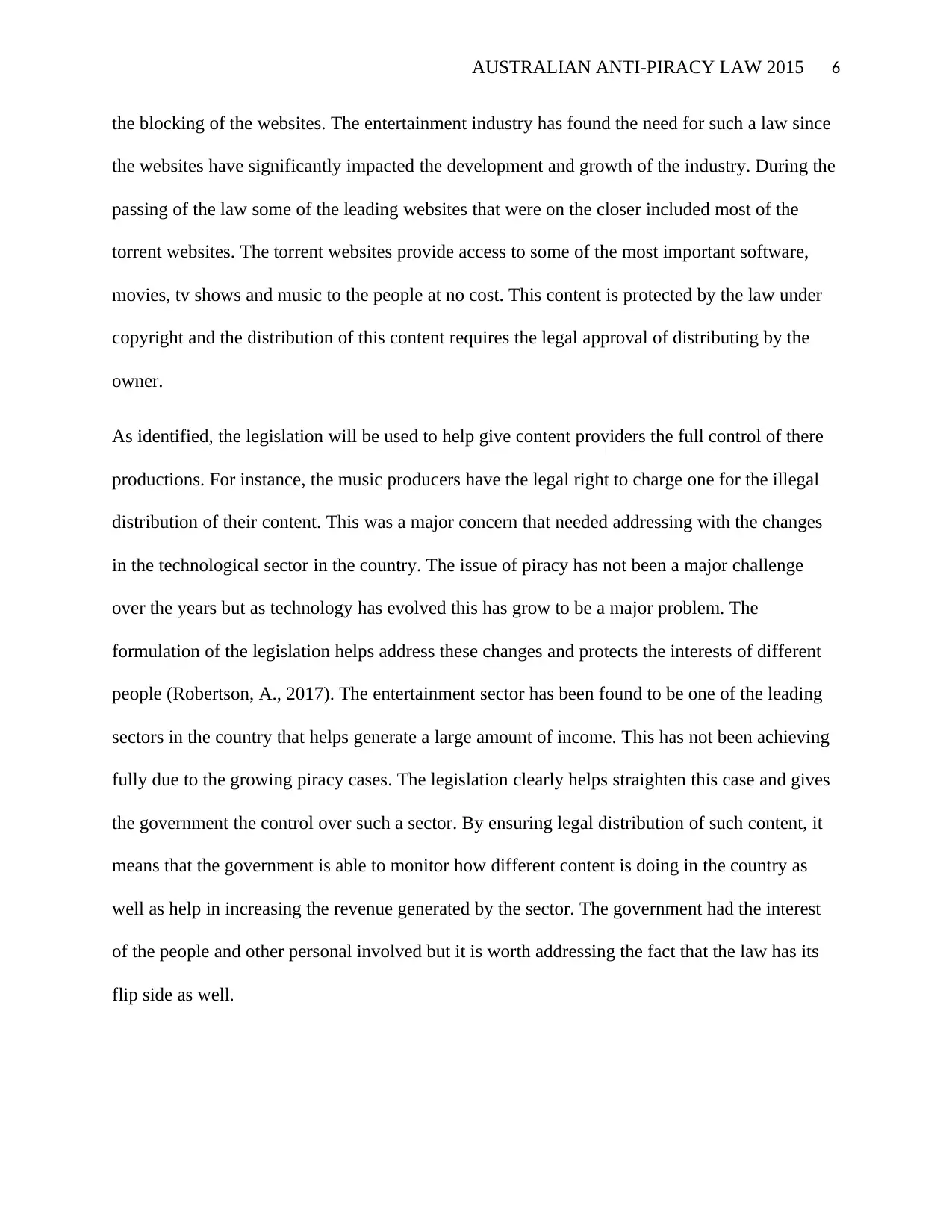
AUSTRALIAN ANTI-PIRACY LAW 2015 6
the blocking of the websites. The entertainment industry has found the need for such a law since
the websites have significantly impacted the development and growth of the industry. During the
passing of the law some of the leading websites that were on the closer included most of the
torrent websites. The torrent websites provide access to some of the most important software,
movies, tv shows and music to the people at no cost. This content is protected by the law under
copyright and the distribution of this content requires the legal approval of distributing by the
owner.
As identified, the legislation will be used to help give content providers the full control of there
productions. For instance, the music producers have the legal right to charge one for the illegal
distribution of their content. This was a major concern that needed addressing with the changes
in the technological sector in the country. The issue of piracy has not been a major challenge
over the years but as technology has evolved this has grow to be a major problem. The
formulation of the legislation helps address these changes and protects the interests of different
people (Robertson, A., 2017). The entertainment sector has been found to be one of the leading
sectors in the country that helps generate a large amount of income. This has not been achieving
fully due to the growing piracy cases. The legislation clearly helps straighten this case and gives
the government the control over such a sector. By ensuring legal distribution of such content, it
means that the government is able to monitor how different content is doing in the country as
well as help in increasing the revenue generated by the sector. The government had the interest
of the people and other personal involved but it is worth addressing the fact that the law has its
flip side as well.
the blocking of the websites. The entertainment industry has found the need for such a law since
the websites have significantly impacted the development and growth of the industry. During the
passing of the law some of the leading websites that were on the closer included most of the
torrent websites. The torrent websites provide access to some of the most important software,
movies, tv shows and music to the people at no cost. This content is protected by the law under
copyright and the distribution of this content requires the legal approval of distributing by the
owner.
As identified, the legislation will be used to help give content providers the full control of there
productions. For instance, the music producers have the legal right to charge one for the illegal
distribution of their content. This was a major concern that needed addressing with the changes
in the technological sector in the country. The issue of piracy has not been a major challenge
over the years but as technology has evolved this has grow to be a major problem. The
formulation of the legislation helps address these changes and protects the interests of different
people (Robertson, A., 2017). The entertainment sector has been found to be one of the leading
sectors in the country that helps generate a large amount of income. This has not been achieving
fully due to the growing piracy cases. The legislation clearly helps straighten this case and gives
the government the control over such a sector. By ensuring legal distribution of such content, it
means that the government is able to monitor how different content is doing in the country as
well as help in increasing the revenue generated by the sector. The government had the interest
of the people and other personal involved but it is worth addressing the fact that the law has its
flip side as well.
You're viewing a preview
Unlock full access by subscribing today!
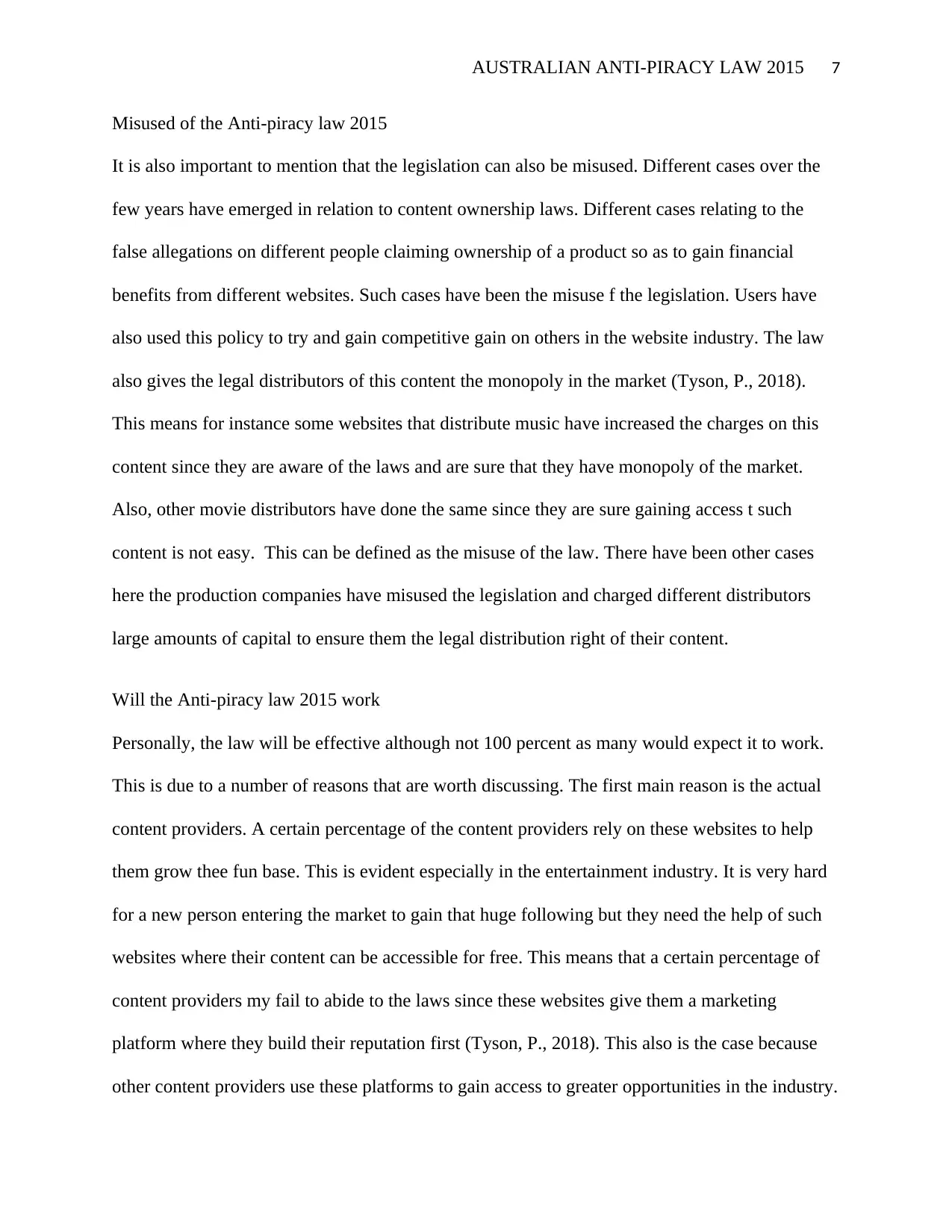
AUSTRALIAN ANTI-PIRACY LAW 2015 7
Misused of the Anti-piracy law 2015
It is also important to mention that the legislation can also be misused. Different cases over the
few years have emerged in relation to content ownership laws. Different cases relating to the
false allegations on different people claiming ownership of a product so as to gain financial
benefits from different websites. Such cases have been the misuse f the legislation. Users have
also used this policy to try and gain competitive gain on others in the website industry. The law
also gives the legal distributors of this content the monopoly in the market (Tyson, P., 2018).
This means for instance some websites that distribute music have increased the charges on this
content since they are aware of the laws and are sure that they have monopoly of the market.
Also, other movie distributors have done the same since they are sure gaining access t such
content is not easy. This can be defined as the misuse of the law. There have been other cases
here the production companies have misused the legislation and charged different distributors
large amounts of capital to ensure them the legal distribution right of their content.
Will the Anti-piracy law 2015 work
Personally, the law will be effective although not 100 percent as many would expect it to work.
This is due to a number of reasons that are worth discussing. The first main reason is the actual
content providers. A certain percentage of the content providers rely on these websites to help
them grow thee fun base. This is evident especially in the entertainment industry. It is very hard
for a new person entering the market to gain that huge following but they need the help of such
websites where their content can be accessible for free. This means that a certain percentage of
content providers my fail to abide to the laws since these websites give them a marketing
platform where they build their reputation first (Tyson, P., 2018). This also is the case because
other content providers use these platforms to gain access to greater opportunities in the industry.
Misused of the Anti-piracy law 2015
It is also important to mention that the legislation can also be misused. Different cases over the
few years have emerged in relation to content ownership laws. Different cases relating to the
false allegations on different people claiming ownership of a product so as to gain financial
benefits from different websites. Such cases have been the misuse f the legislation. Users have
also used this policy to try and gain competitive gain on others in the website industry. The law
also gives the legal distributors of this content the monopoly in the market (Tyson, P., 2018).
This means for instance some websites that distribute music have increased the charges on this
content since they are aware of the laws and are sure that they have monopoly of the market.
Also, other movie distributors have done the same since they are sure gaining access t such
content is not easy. This can be defined as the misuse of the law. There have been other cases
here the production companies have misused the legislation and charged different distributors
large amounts of capital to ensure them the legal distribution right of their content.
Will the Anti-piracy law 2015 work
Personally, the law will be effective although not 100 percent as many would expect it to work.
This is due to a number of reasons that are worth discussing. The first main reason is the actual
content providers. A certain percentage of the content providers rely on these websites to help
them grow thee fun base. This is evident especially in the entertainment industry. It is very hard
for a new person entering the market to gain that huge following but they need the help of such
websites where their content can be accessible for free. This means that a certain percentage of
content providers my fail to abide to the laws since these websites give them a marketing
platform where they build their reputation first (Tyson, P., 2018). This also is the case because
other content providers use these platforms to gain access to greater opportunities in the industry.
Paraphrase This Document
Need a fresh take? Get an instant paraphrase of this document with our AI Paraphraser
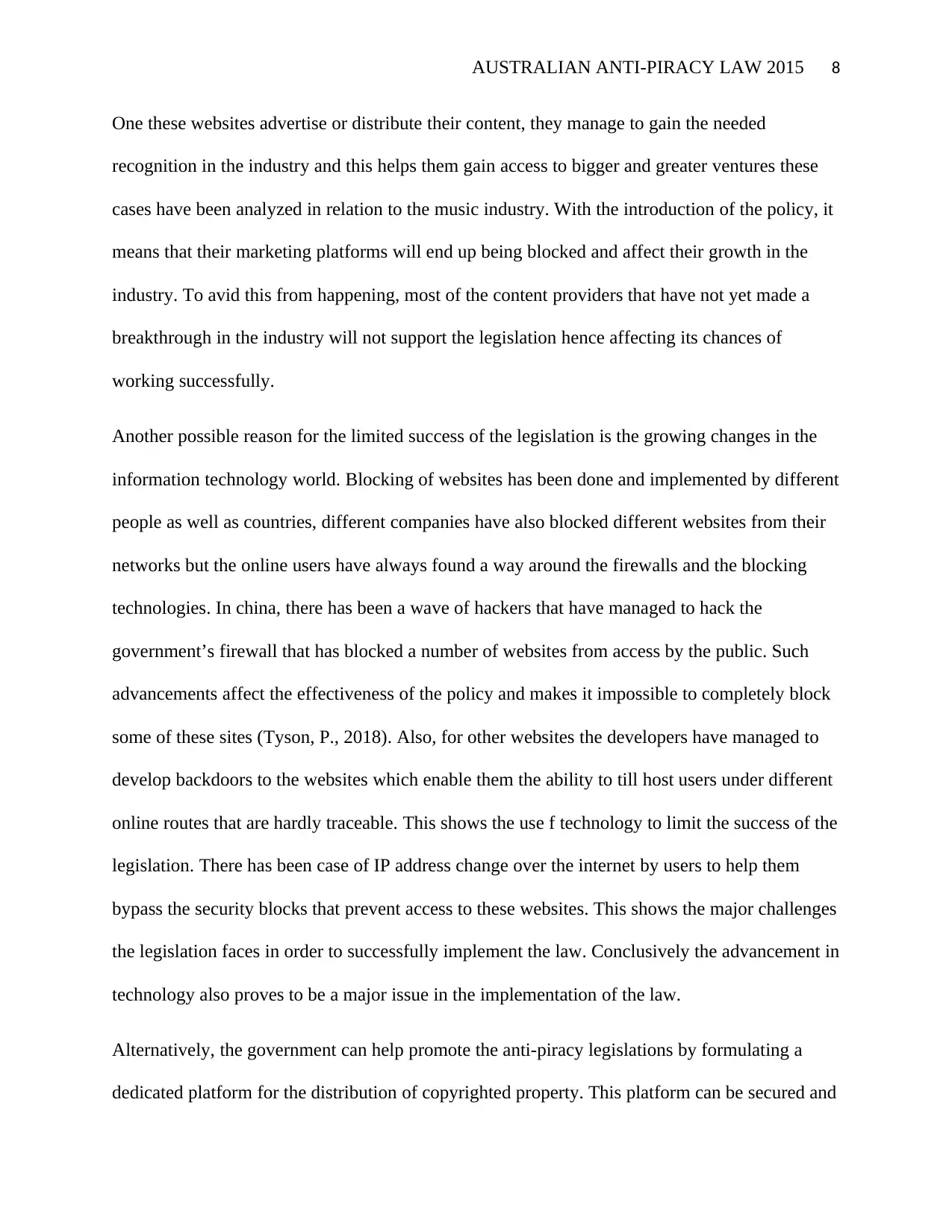
AUSTRALIAN ANTI-PIRACY LAW 2015 8
One these websites advertise or distribute their content, they manage to gain the needed
recognition in the industry and this helps them gain access to bigger and greater ventures these
cases have been analyzed in relation to the music industry. With the introduction of the policy, it
means that their marketing platforms will end up being blocked and affect their growth in the
industry. To avid this from happening, most of the content providers that have not yet made a
breakthrough in the industry will not support the legislation hence affecting its chances of
working successfully.
Another possible reason for the limited success of the legislation is the growing changes in the
information technology world. Blocking of websites has been done and implemented by different
people as well as countries, different companies have also blocked different websites from their
networks but the online users have always found a way around the firewalls and the blocking
technologies. In china, there has been a wave of hackers that have managed to hack the
government’s firewall that has blocked a number of websites from access by the public. Such
advancements affect the effectiveness of the policy and makes it impossible to completely block
some of these sites (Tyson, P., 2018). Also, for other websites the developers have managed to
develop backdoors to the websites which enable them the ability to till host users under different
online routes that are hardly traceable. This shows the use f technology to limit the success of the
legislation. There has been case of IP address change over the internet by users to help them
bypass the security blocks that prevent access to these websites. This shows the major challenges
the legislation faces in order to successfully implement the law. Conclusively the advancement in
technology also proves to be a major issue in the implementation of the law.
Alternatively, the government can help promote the anti-piracy legislations by formulating a
dedicated platform for the distribution of copyrighted property. This platform can be secured and
One these websites advertise or distribute their content, they manage to gain the needed
recognition in the industry and this helps them gain access to bigger and greater ventures these
cases have been analyzed in relation to the music industry. With the introduction of the policy, it
means that their marketing platforms will end up being blocked and affect their growth in the
industry. To avid this from happening, most of the content providers that have not yet made a
breakthrough in the industry will not support the legislation hence affecting its chances of
working successfully.
Another possible reason for the limited success of the legislation is the growing changes in the
information technology world. Blocking of websites has been done and implemented by different
people as well as countries, different companies have also blocked different websites from their
networks but the online users have always found a way around the firewalls and the blocking
technologies. In china, there has been a wave of hackers that have managed to hack the
government’s firewall that has blocked a number of websites from access by the public. Such
advancements affect the effectiveness of the policy and makes it impossible to completely block
some of these sites (Tyson, P., 2018). Also, for other websites the developers have managed to
develop backdoors to the websites which enable them the ability to till host users under different
online routes that are hardly traceable. This shows the use f technology to limit the success of the
legislation. There has been case of IP address change over the internet by users to help them
bypass the security blocks that prevent access to these websites. This shows the major challenges
the legislation faces in order to successfully implement the law. Conclusively the advancement in
technology also proves to be a major issue in the implementation of the law.
Alternatively, the government can help promote the anti-piracy legislations by formulating a
dedicated platform for the distribution of copyrighted property. This platform can be secured and
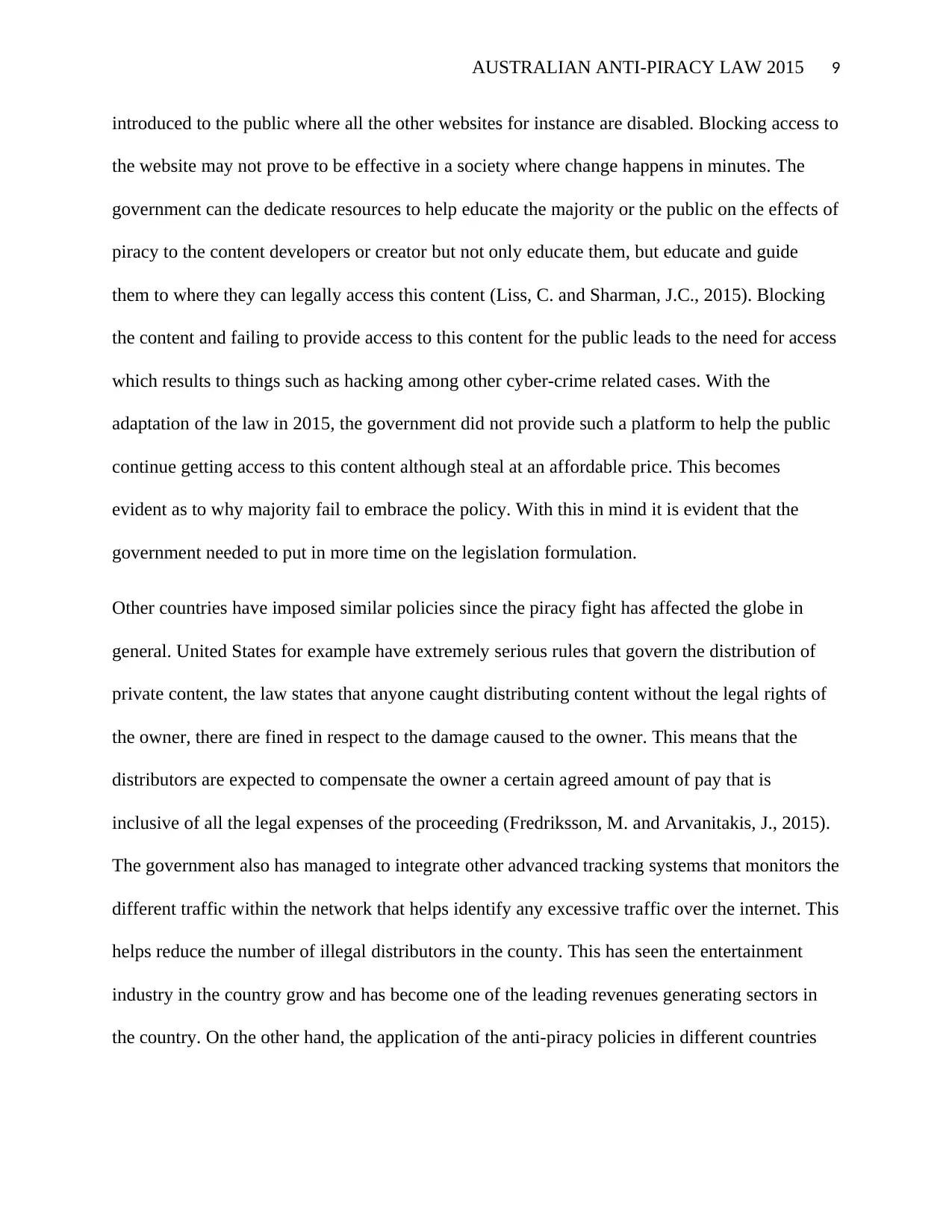
AUSTRALIAN ANTI-PIRACY LAW 2015 9
introduced to the public where all the other websites for instance are disabled. Blocking access to
the website may not prove to be effective in a society where change happens in minutes. The
government can the dedicate resources to help educate the majority or the public on the effects of
piracy to the content developers or creator but not only educate them, but educate and guide
them to where they can legally access this content (Liss, C. and Sharman, J.C., 2015). Blocking
the content and failing to provide access to this content for the public leads to the need for access
which results to things such as hacking among other cyber-crime related cases. With the
adaptation of the law in 2015, the government did not provide such a platform to help the public
continue getting access to this content although steal at an affordable price. This becomes
evident as to why majority fail to embrace the policy. With this in mind it is evident that the
government needed to put in more time on the legislation formulation.
Other countries have imposed similar policies since the piracy fight has affected the globe in
general. United States for example have extremely serious rules that govern the distribution of
private content, the law states that anyone caught distributing content without the legal rights of
the owner, there are fined in respect to the damage caused to the owner. This means that the
distributors are expected to compensate the owner a certain agreed amount of pay that is
inclusive of all the legal expenses of the proceeding (Fredriksson, M. and Arvanitakis, J., 2015).
The government also has managed to integrate other advanced tracking systems that monitors the
different traffic within the network that helps identify any excessive traffic over the internet. This
helps reduce the number of illegal distributors in the county. This has seen the entertainment
industry in the country grow and has become one of the leading revenues generating sectors in
the country. On the other hand, the application of the anti-piracy policies in different countries
introduced to the public where all the other websites for instance are disabled. Blocking access to
the website may not prove to be effective in a society where change happens in minutes. The
government can the dedicate resources to help educate the majority or the public on the effects of
piracy to the content developers or creator but not only educate them, but educate and guide
them to where they can legally access this content (Liss, C. and Sharman, J.C., 2015). Blocking
the content and failing to provide access to this content for the public leads to the need for access
which results to things such as hacking among other cyber-crime related cases. With the
adaptation of the law in 2015, the government did not provide such a platform to help the public
continue getting access to this content although steal at an affordable price. This becomes
evident as to why majority fail to embrace the policy. With this in mind it is evident that the
government needed to put in more time on the legislation formulation.
Other countries have imposed similar policies since the piracy fight has affected the globe in
general. United States for example have extremely serious rules that govern the distribution of
private content, the law states that anyone caught distributing content without the legal rights of
the owner, there are fined in respect to the damage caused to the owner. This means that the
distributors are expected to compensate the owner a certain agreed amount of pay that is
inclusive of all the legal expenses of the proceeding (Fredriksson, M. and Arvanitakis, J., 2015).
The government also has managed to integrate other advanced tracking systems that monitors the
different traffic within the network that helps identify any excessive traffic over the internet. This
helps reduce the number of illegal distributors in the county. This has seen the entertainment
industry in the country grow and has become one of the leading revenues generating sectors in
the country. On the other hand, the application of the anti-piracy policies in different countries
You're viewing a preview
Unlock full access by subscribing today!
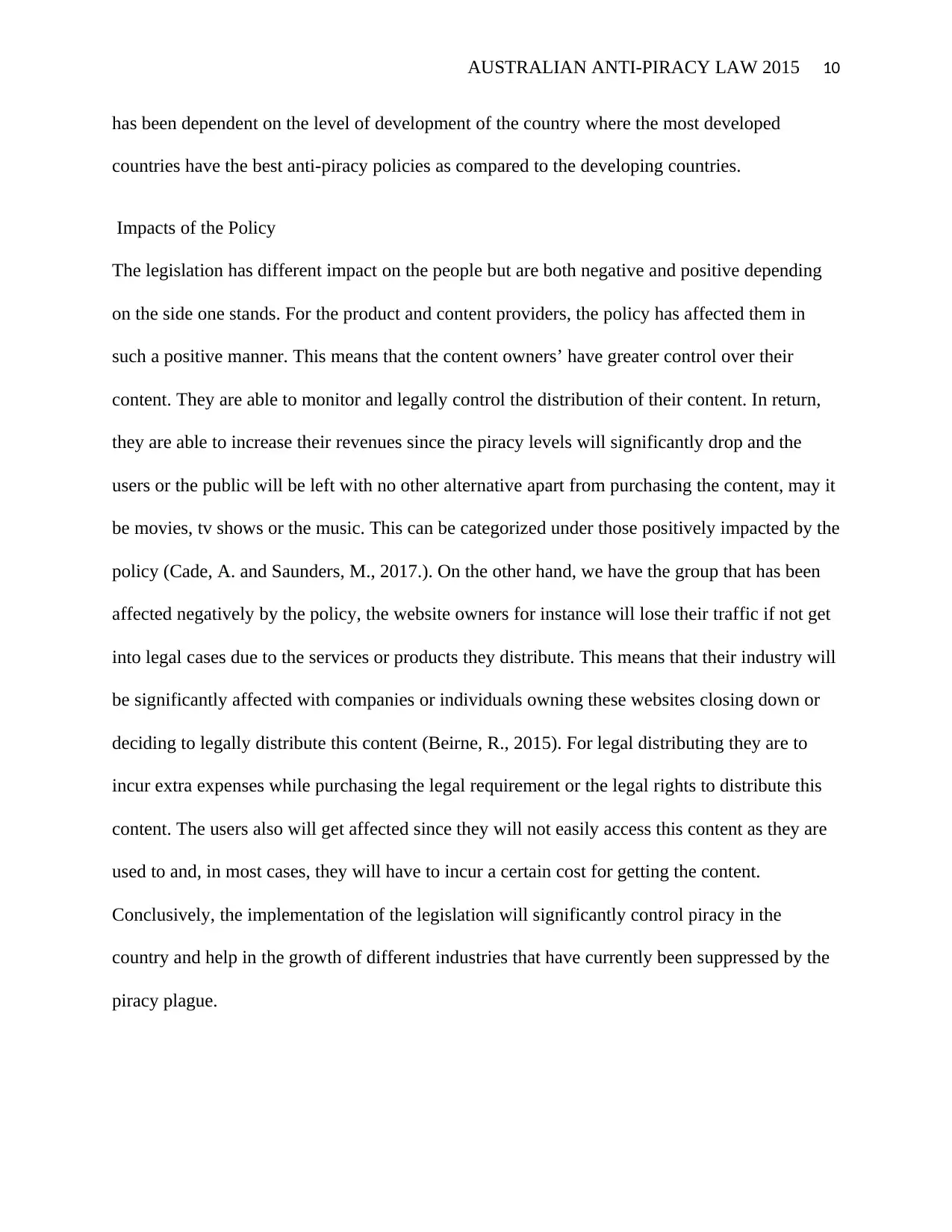
AUSTRALIAN ANTI-PIRACY LAW 2015 10
has been dependent on the level of development of the country where the most developed
countries have the best anti-piracy policies as compared to the developing countries.
Impacts of the Policy
The legislation has different impact on the people but are both negative and positive depending
on the side one stands. For the product and content providers, the policy has affected them in
such a positive manner. This means that the content owners’ have greater control over their
content. They are able to monitor and legally control the distribution of their content. In return,
they are able to increase their revenues since the piracy levels will significantly drop and the
users or the public will be left with no other alternative apart from purchasing the content, may it
be movies, tv shows or the music. This can be categorized under those positively impacted by the
policy (Cade, A. and Saunders, M., 2017.). On the other hand, we have the group that has been
affected negatively by the policy, the website owners for instance will lose their traffic if not get
into legal cases due to the services or products they distribute. This means that their industry will
be significantly affected with companies or individuals owning these websites closing down or
deciding to legally distribute this content (Beirne, R., 2015). For legal distributing they are to
incur extra expenses while purchasing the legal requirement or the legal rights to distribute this
content. The users also will get affected since they will not easily access this content as they are
used to and, in most cases, they will have to incur a certain cost for getting the content.
Conclusively, the implementation of the legislation will significantly control piracy in the
country and help in the growth of different industries that have currently been suppressed by the
piracy plague.
has been dependent on the level of development of the country where the most developed
countries have the best anti-piracy policies as compared to the developing countries.
Impacts of the Policy
The legislation has different impact on the people but are both negative and positive depending
on the side one stands. For the product and content providers, the policy has affected them in
such a positive manner. This means that the content owners’ have greater control over their
content. They are able to monitor and legally control the distribution of their content. In return,
they are able to increase their revenues since the piracy levels will significantly drop and the
users or the public will be left with no other alternative apart from purchasing the content, may it
be movies, tv shows or the music. This can be categorized under those positively impacted by the
policy (Cade, A. and Saunders, M., 2017.). On the other hand, we have the group that has been
affected negatively by the policy, the website owners for instance will lose their traffic if not get
into legal cases due to the services or products they distribute. This means that their industry will
be significantly affected with companies or individuals owning these websites closing down or
deciding to legally distribute this content (Beirne, R., 2015). For legal distributing they are to
incur extra expenses while purchasing the legal requirement or the legal rights to distribute this
content. The users also will get affected since they will not easily access this content as they are
used to and, in most cases, they will have to incur a certain cost for getting the content.
Conclusively, the implementation of the legislation will significantly control piracy in the
country and help in the growth of different industries that have currently been suppressed by the
piracy plague.
Paraphrase This Document
Need a fresh take? Get an instant paraphrase of this document with our AI Paraphraser
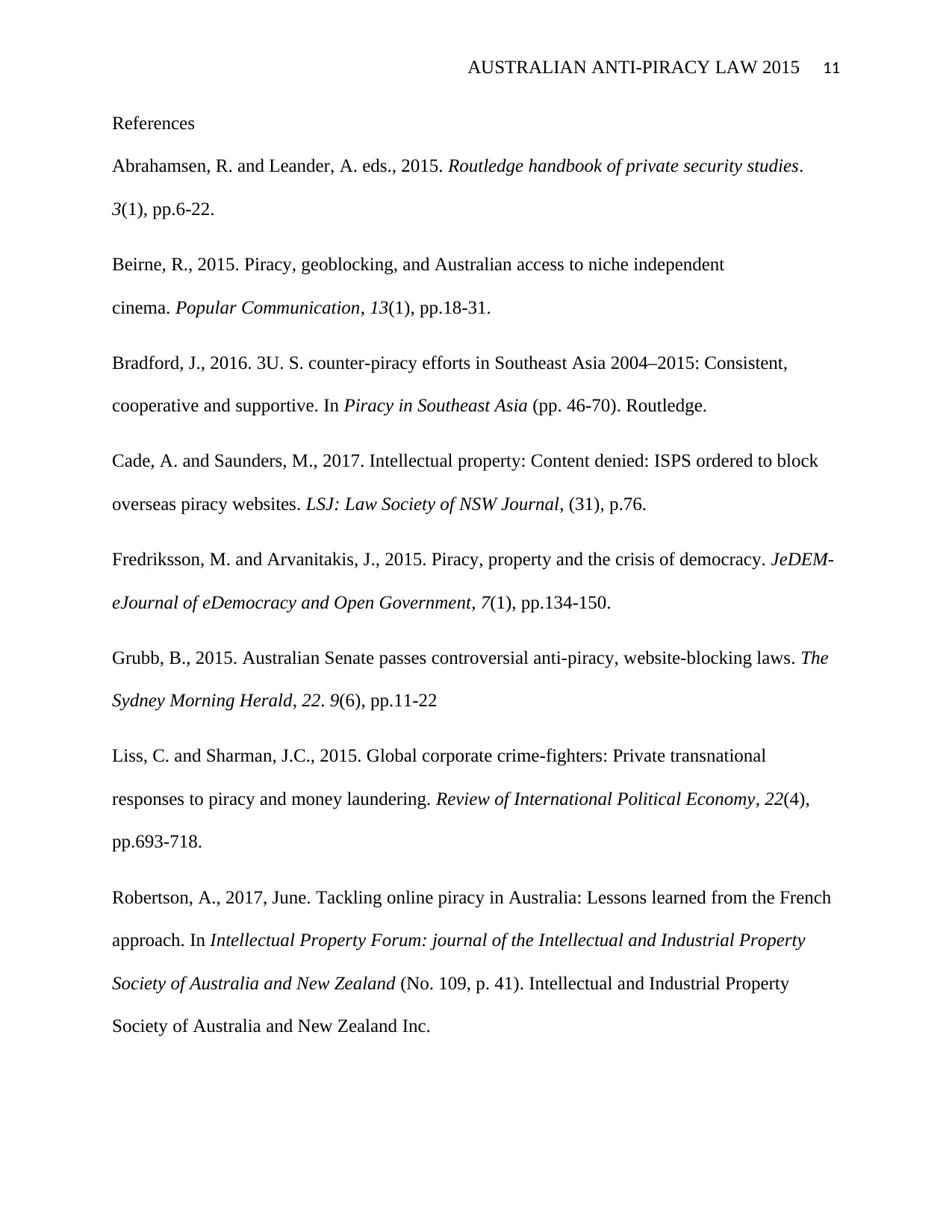
AUSTRALIAN ANTI-PIRACY LAW 2015 11
References
Abrahamsen, R. and Leander, A. eds., 2015. Routledge handbook of private security studies.
3(1), pp.6-22.
Beirne, R., 2015. Piracy, geoblocking, and Australian access to niche independent
cinema. Popular Communication, 13(1), pp.18-31.
Bradford, J., 2016. 3U. S. counter-piracy efforts in Southeast Asia 2004–2015: Consistent,
cooperative and supportive. In Piracy in Southeast Asia (pp. 46-70). Routledge.
Cade, A. and Saunders, M., 2017. Intellectual property: Content denied: ISPS ordered to block
overseas piracy websites. LSJ: Law Society of NSW Journal, (31), p.76.
Fredriksson, M. and Arvanitakis, J., 2015. Piracy, property and the crisis of democracy. JeDEM-
eJournal of eDemocracy and Open Government, 7(1), pp.134-150.
Grubb, B., 2015. Australian Senate passes controversial anti-piracy, website-blocking laws. The
Sydney Morning Herald, 22. 9(6), pp.11-22
Liss, C. and Sharman, J.C., 2015. Global corporate crime-fighters: Private transnational
responses to piracy and money laundering. Review of International Political Economy, 22(4),
pp.693-718.
Robertson, A., 2017, June. Tackling online piracy in Australia: Lessons learned from the French
approach. In Intellectual Property Forum: journal of the Intellectual and Industrial Property
Society of Australia and New Zealand (No. 109, p. 41). Intellectual and Industrial Property
Society of Australia and New Zealand Inc.
References
Abrahamsen, R. and Leander, A. eds., 2015. Routledge handbook of private security studies.
3(1), pp.6-22.
Beirne, R., 2015. Piracy, geoblocking, and Australian access to niche independent
cinema. Popular Communication, 13(1), pp.18-31.
Bradford, J., 2016. 3U. S. counter-piracy efforts in Southeast Asia 2004–2015: Consistent,
cooperative and supportive. In Piracy in Southeast Asia (pp. 46-70). Routledge.
Cade, A. and Saunders, M., 2017. Intellectual property: Content denied: ISPS ordered to block
overseas piracy websites. LSJ: Law Society of NSW Journal, (31), p.76.
Fredriksson, M. and Arvanitakis, J., 2015. Piracy, property and the crisis of democracy. JeDEM-
eJournal of eDemocracy and Open Government, 7(1), pp.134-150.
Grubb, B., 2015. Australian Senate passes controversial anti-piracy, website-blocking laws. The
Sydney Morning Herald, 22. 9(6), pp.11-22
Liss, C. and Sharman, J.C., 2015. Global corporate crime-fighters: Private transnational
responses to piracy and money laundering. Review of International Political Economy, 22(4),
pp.693-718.
Robertson, A., 2017, June. Tackling online piracy in Australia: Lessons learned from the French
approach. In Intellectual Property Forum: journal of the Intellectual and Industrial Property
Society of Australia and New Zealand (No. 109, p. 41). Intellectual and Industrial Property
Society of Australia and New Zealand Inc.
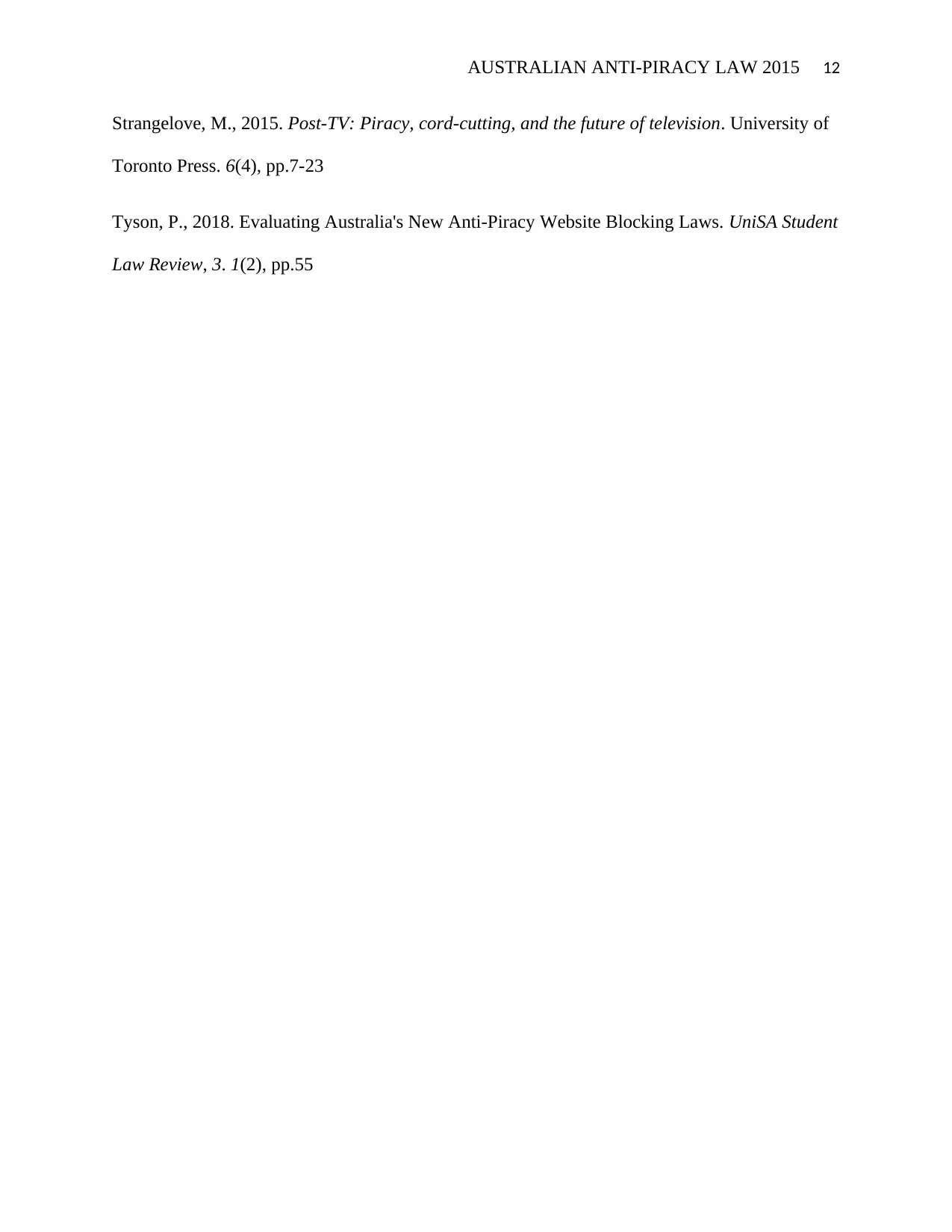
AUSTRALIAN ANTI-PIRACY LAW 2015 12
Strangelove, M., 2015. Post-TV: Piracy, cord-cutting, and the future of television. University of
Toronto Press. 6(4), pp.7-23
Tyson, P., 2018. Evaluating Australia's New Anti-Piracy Website Blocking Laws. UniSA Student
Law Review, 3. 1(2), pp.55
Strangelove, M., 2015. Post-TV: Piracy, cord-cutting, and the future of television. University of
Toronto Press. 6(4), pp.7-23
Tyson, P., 2018. Evaluating Australia's New Anti-Piracy Website Blocking Laws. UniSA Student
Law Review, 3. 1(2), pp.55
You're viewing a preview
Unlock full access by subscribing today!
1 out of 12
Related Documents
Your All-in-One AI-Powered Toolkit for Academic Success.
+13062052269
info@desklib.com
Available 24*7 on WhatsApp / Email
![[object Object]](/_next/static/media/star-bottom.7253800d.svg)
Unlock your academic potential
© 2024 | Zucol Services PVT LTD | All rights reserved.




